Injection Moulding Polymers: Major Steps, Properties, Processing Parameters and Shrinkage
VerifiedAdded on 2023/06/13
|9
|1814
|386
AI Summary
This article discusses the major steps involved in the injection moulding process, properties of polymers influencing MFI, processing parameters and shrinkage. It also covers the influence of pressure, temperature and time on mechanical properties.
Contribute Materials
Your contribution can guide someone’s learning journey. Share your
documents today.
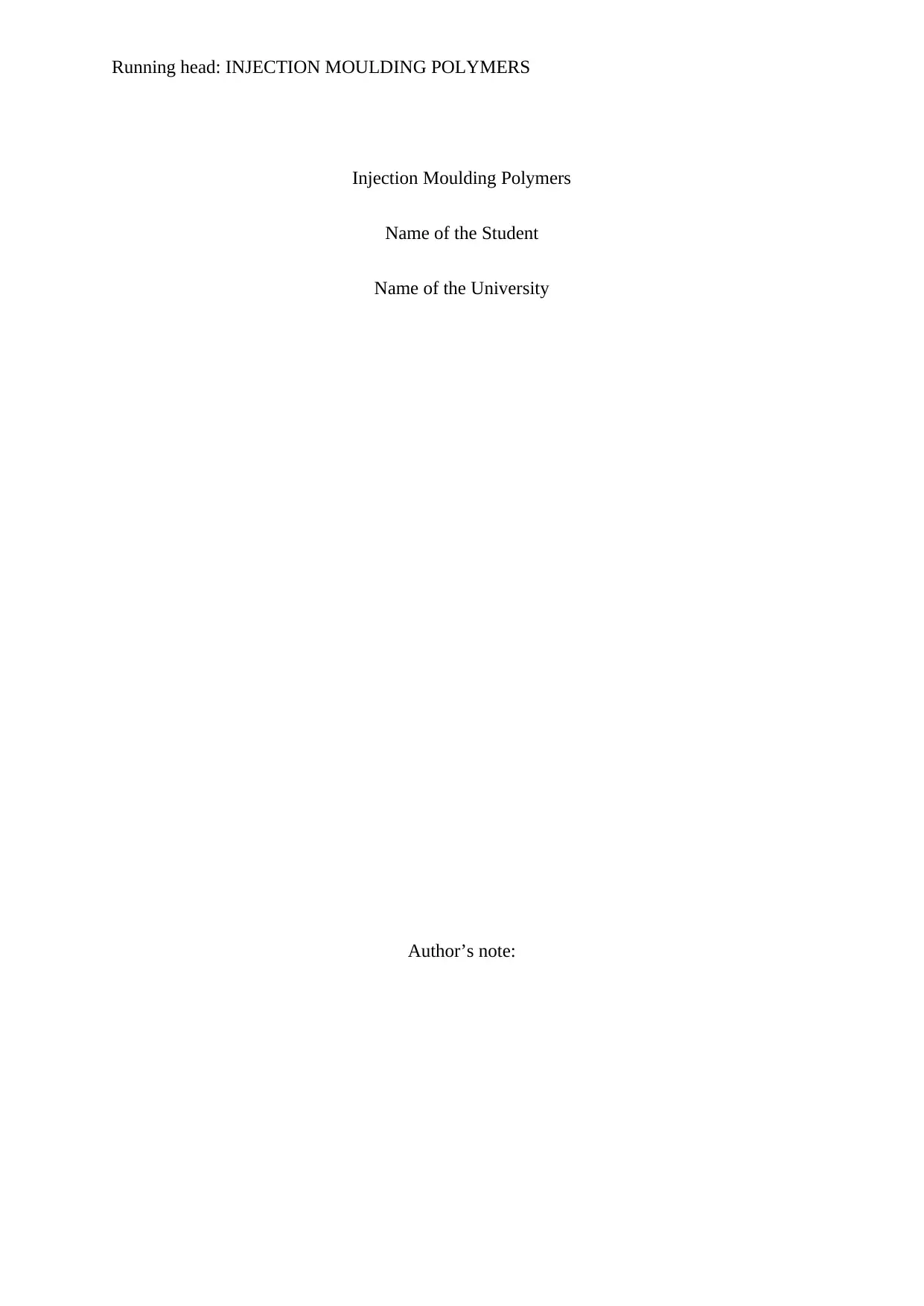
Running head: INJECTION MOULDING POLYMERS
Injection Moulding Polymers
Name of the Student
Name of the University
Author’s note:
Injection Moulding Polymers
Name of the Student
Name of the University
Author’s note:
Secure Best Marks with AI Grader
Need help grading? Try our AI Grader for instant feedback on your assignments.
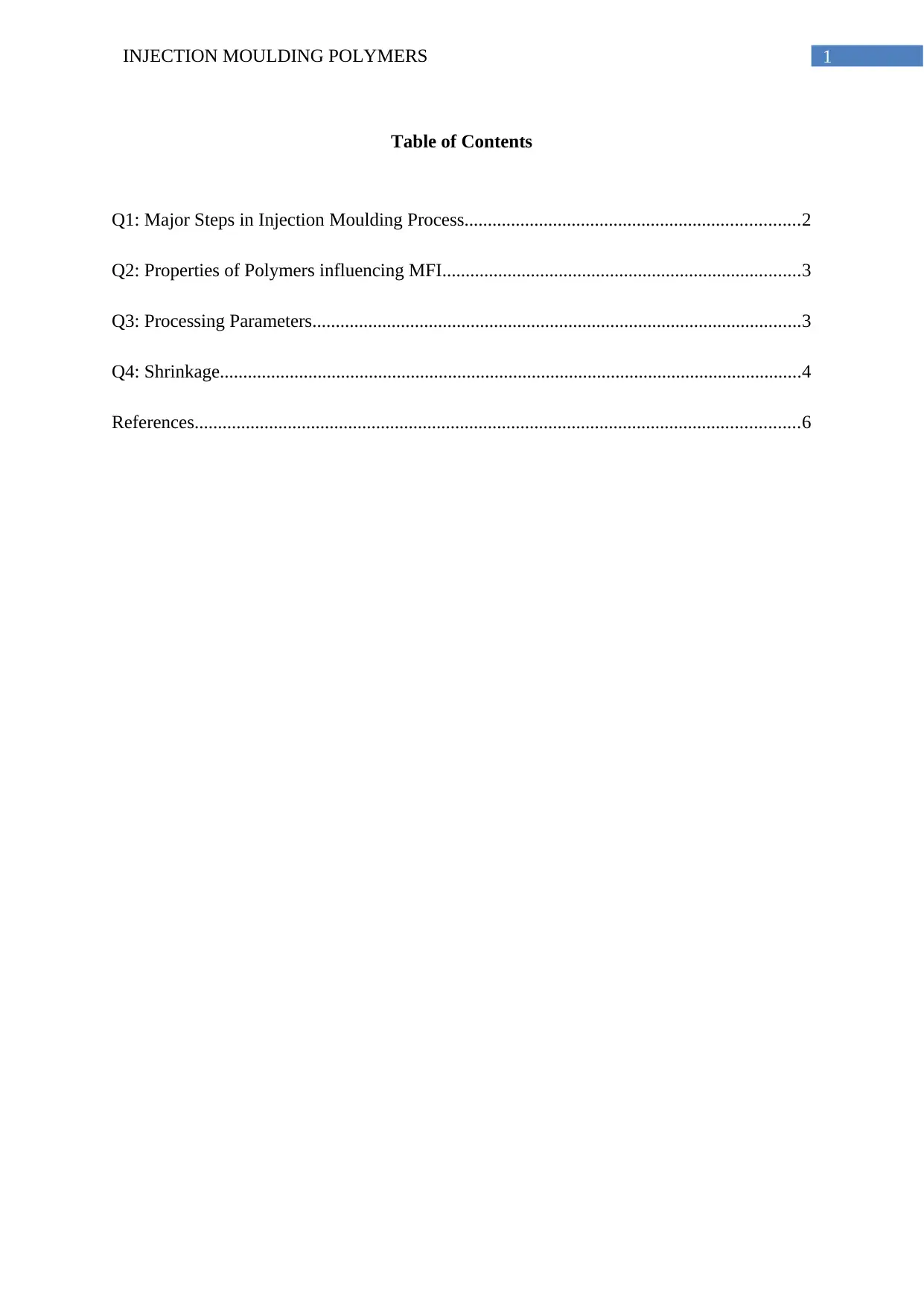
1INJECTION MOULDING POLYMERS
Table of Contents
Q1: Major Steps in Injection Moulding Process........................................................................2
Q2: Properties of Polymers influencing MFI.............................................................................3
Q3: Processing Parameters.........................................................................................................3
Q4: Shrinkage.............................................................................................................................4
References..................................................................................................................................6
Table of Contents
Q1: Major Steps in Injection Moulding Process........................................................................2
Q2: Properties of Polymers influencing MFI.............................................................................3
Q3: Processing Parameters.........................................................................................................3
Q4: Shrinkage.............................................................................................................................4
References..................................................................................................................................6
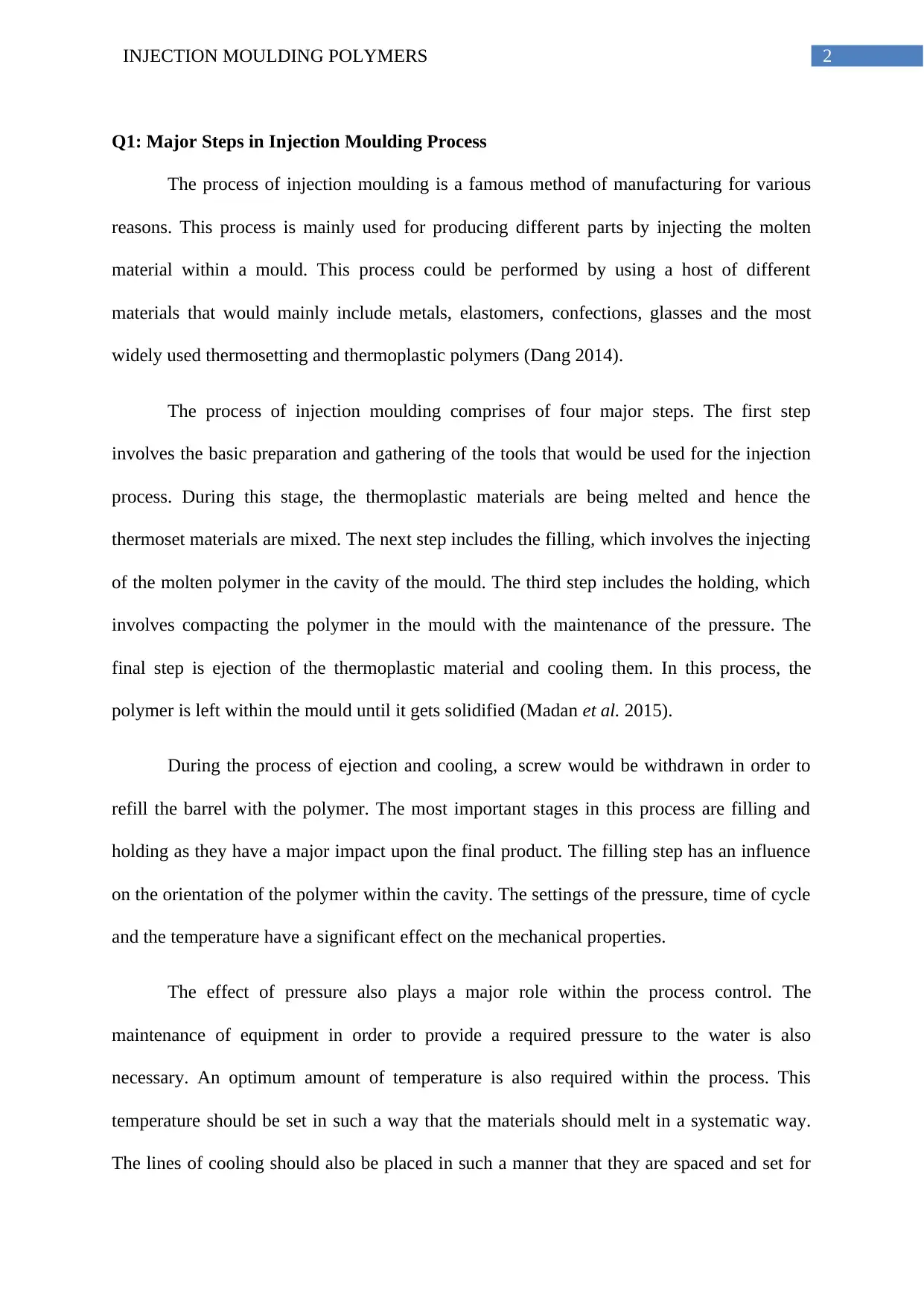
2INJECTION MOULDING POLYMERS
Q1: Major Steps in Injection Moulding Process
The process of injection moulding is a famous method of manufacturing for various
reasons. This process is mainly used for producing different parts by injecting the molten
material within a mould. This process could be performed by using a host of different
materials that would mainly include metals, elastomers, confections, glasses and the most
widely used thermosetting and thermoplastic polymers (Dang 2014).
The process of injection moulding comprises of four major steps. The first step
involves the basic preparation and gathering of the tools that would be used for the injection
process. During this stage, the thermoplastic materials are being melted and hence the
thermoset materials are mixed. The next step includes the filling, which involves the injecting
of the molten polymer in the cavity of the mould. The third step includes the holding, which
involves compacting the polymer in the mould with the maintenance of the pressure. The
final step is ejection of the thermoplastic material and cooling them. In this process, the
polymer is left within the mould until it gets solidified (Madan et al. 2015).
During the process of ejection and cooling, a screw would be withdrawn in order to
refill the barrel with the polymer. The most important stages in this process are filling and
holding as they have a major impact upon the final product. The filling step has an influence
on the orientation of the polymer within the cavity. The settings of the pressure, time of cycle
and the temperature have a significant effect on the mechanical properties.
The effect of pressure also plays a major role within the process control. The
maintenance of equipment in order to provide a required pressure to the water is also
necessary. An optimum amount of temperature is also required within the process. This
temperature should be set in such a way that the materials should melt in a systematic way.
The lines of cooling should also be placed in such a manner that they are spaced and set for
Q1: Major Steps in Injection Moulding Process
The process of injection moulding is a famous method of manufacturing for various
reasons. This process is mainly used for producing different parts by injecting the molten
material within a mould. This process could be performed by using a host of different
materials that would mainly include metals, elastomers, confections, glasses and the most
widely used thermosetting and thermoplastic polymers (Dang 2014).
The process of injection moulding comprises of four major steps. The first step
involves the basic preparation and gathering of the tools that would be used for the injection
process. During this stage, the thermoplastic materials are being melted and hence the
thermoset materials are mixed. The next step includes the filling, which involves the injecting
of the molten polymer in the cavity of the mould. The third step includes the holding, which
involves compacting the polymer in the mould with the maintenance of the pressure. The
final step is ejection of the thermoplastic material and cooling them. In this process, the
polymer is left within the mould until it gets solidified (Madan et al. 2015).
During the process of ejection and cooling, a screw would be withdrawn in order to
refill the barrel with the polymer. The most important stages in this process are filling and
holding as they have a major impact upon the final product. The filling step has an influence
on the orientation of the polymer within the cavity. The settings of the pressure, time of cycle
and the temperature have a significant effect on the mechanical properties.
The effect of pressure also plays a major role within the process control. The
maintenance of equipment in order to provide a required pressure to the water is also
necessary. An optimum amount of temperature is also required within the process. This
temperature should be set in such a way that the materials should melt in a systematic way.
The lines of cooling should also be placed in such a manner that they are spaced and set for
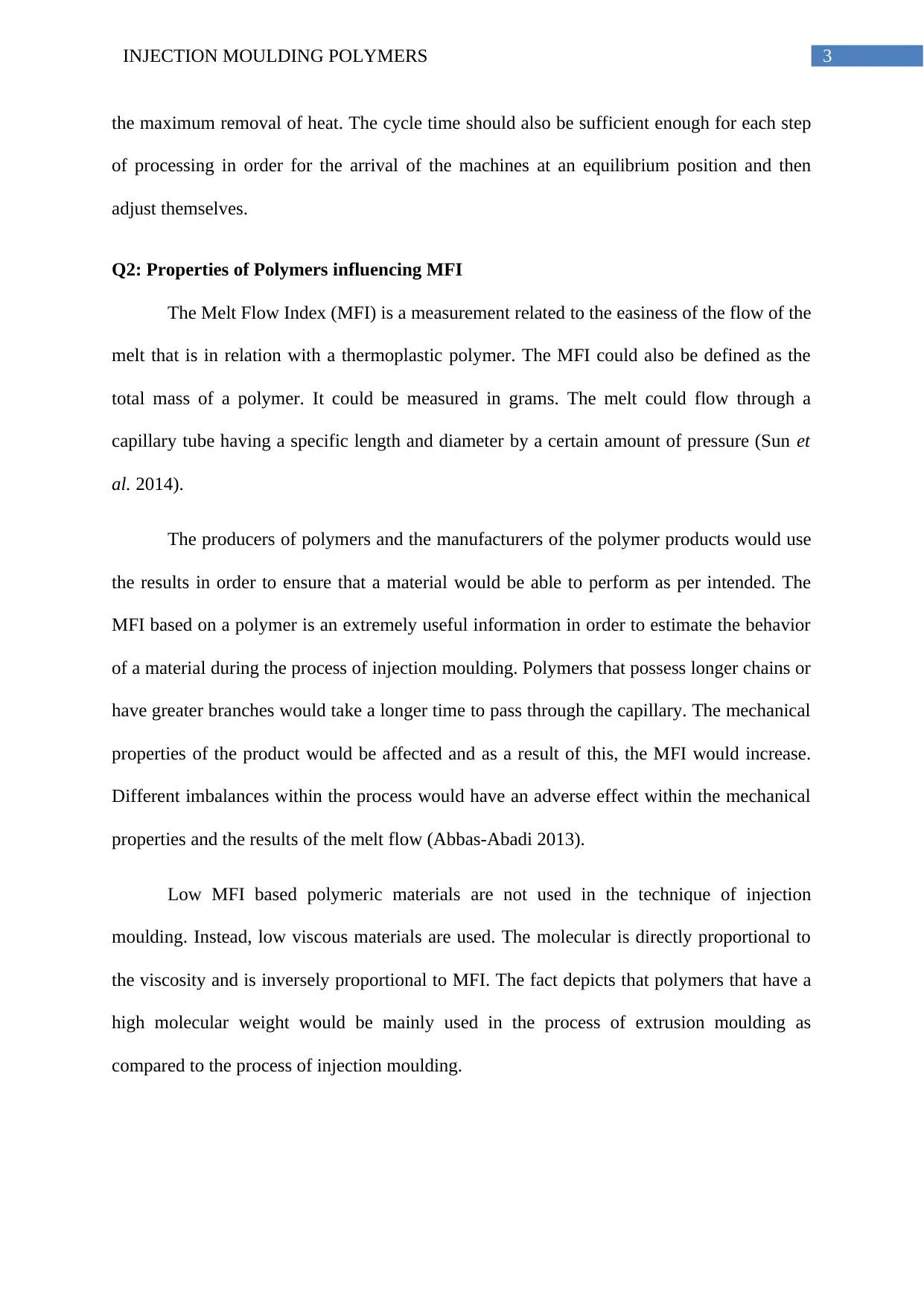
3INJECTION MOULDING POLYMERS
the maximum removal of heat. The cycle time should also be sufficient enough for each step
of processing in order for the arrival of the machines at an equilibrium position and then
adjust themselves.
Q2: Properties of Polymers influencing MFI
The Melt Flow Index (MFI) is a measurement related to the easiness of the flow of the
melt that is in relation with a thermoplastic polymer. The MFI could also be defined as the
total mass of a polymer. It could be measured in grams. The melt could flow through a
capillary tube having a specific length and diameter by a certain amount of pressure (Sun et
al. 2014).
The producers of polymers and the manufacturers of the polymer products would use
the results in order to ensure that a material would be able to perform as per intended. The
MFI based on a polymer is an extremely useful information in order to estimate the behavior
of a material during the process of injection moulding. Polymers that possess longer chains or
have greater branches would take a longer time to pass through the capillary. The mechanical
properties of the product would be affected and as a result of this, the MFI would increase.
Different imbalances within the process would have an adverse effect within the mechanical
properties and the results of the melt flow (Abbas-Abadi 2013).
Low MFI based polymeric materials are not used in the technique of injection
moulding. Instead, low viscous materials are used. The molecular is directly proportional to
the viscosity and is inversely proportional to MFI. The fact depicts that polymers that have a
high molecular weight would be mainly used in the process of extrusion moulding as
compared to the process of injection moulding.
the maximum removal of heat. The cycle time should also be sufficient enough for each step
of processing in order for the arrival of the machines at an equilibrium position and then
adjust themselves.
Q2: Properties of Polymers influencing MFI
The Melt Flow Index (MFI) is a measurement related to the easiness of the flow of the
melt that is in relation with a thermoplastic polymer. The MFI could also be defined as the
total mass of a polymer. It could be measured in grams. The melt could flow through a
capillary tube having a specific length and diameter by a certain amount of pressure (Sun et
al. 2014).
The producers of polymers and the manufacturers of the polymer products would use
the results in order to ensure that a material would be able to perform as per intended. The
MFI based on a polymer is an extremely useful information in order to estimate the behavior
of a material during the process of injection moulding. Polymers that possess longer chains or
have greater branches would take a longer time to pass through the capillary. The mechanical
properties of the product would be affected and as a result of this, the MFI would increase.
Different imbalances within the process would have an adverse effect within the mechanical
properties and the results of the melt flow (Abbas-Abadi 2013).
Low MFI based polymeric materials are not used in the technique of injection
moulding. Instead, low viscous materials are used. The molecular is directly proportional to
the viscosity and is inversely proportional to MFI. The fact depicts that polymers that have a
high molecular weight would be mainly used in the process of extrusion moulding as
compared to the process of injection moulding.
Secure Best Marks with AI Grader
Need help grading? Try our AI Grader for instant feedback on your assignments.
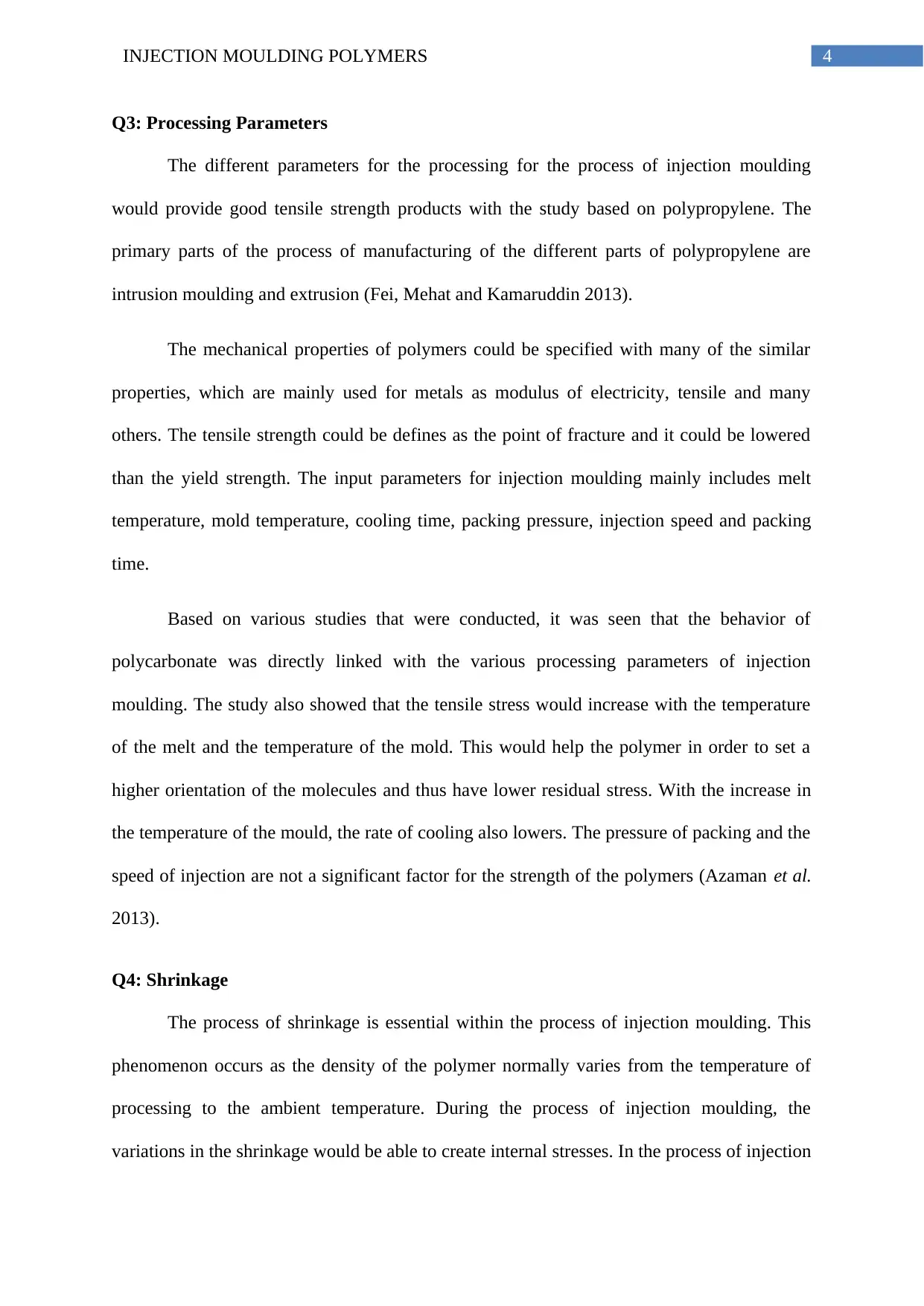
4INJECTION MOULDING POLYMERS
Q3: Processing Parameters
The different parameters for the processing for the process of injection moulding
would provide good tensile strength products with the study based on polypropylene. The
primary parts of the process of manufacturing of the different parts of polypropylene are
intrusion moulding and extrusion (Fei, Mehat and Kamaruddin 2013).
The mechanical properties of polymers could be specified with many of the similar
properties, which are mainly used for metals as modulus of electricity, tensile and many
others. The tensile strength could be defines as the point of fracture and it could be lowered
than the yield strength. The input parameters for injection moulding mainly includes melt
temperature, mold temperature, cooling time, packing pressure, injection speed and packing
time.
Based on various studies that were conducted, it was seen that the behavior of
polycarbonate was directly linked with the various processing parameters of injection
moulding. The study also showed that the tensile stress would increase with the temperature
of the melt and the temperature of the mold. This would help the polymer in order to set a
higher orientation of the molecules and thus have lower residual stress. With the increase in
the temperature of the mould, the rate of cooling also lowers. The pressure of packing and the
speed of injection are not a significant factor for the strength of the polymers (Azaman et al.
2013).
Q4: Shrinkage
The process of shrinkage is essential within the process of injection moulding. This
phenomenon occurs as the density of the polymer normally varies from the temperature of
processing to the ambient temperature. During the process of injection moulding, the
variations in the shrinkage would be able to create internal stresses. In the process of injection
Q3: Processing Parameters
The different parameters for the processing for the process of injection moulding
would provide good tensile strength products with the study based on polypropylene. The
primary parts of the process of manufacturing of the different parts of polypropylene are
intrusion moulding and extrusion (Fei, Mehat and Kamaruddin 2013).
The mechanical properties of polymers could be specified with many of the similar
properties, which are mainly used for metals as modulus of electricity, tensile and many
others. The tensile strength could be defines as the point of fracture and it could be lowered
than the yield strength. The input parameters for injection moulding mainly includes melt
temperature, mold temperature, cooling time, packing pressure, injection speed and packing
time.
Based on various studies that were conducted, it was seen that the behavior of
polycarbonate was directly linked with the various processing parameters of injection
moulding. The study also showed that the tensile stress would increase with the temperature
of the melt and the temperature of the mold. This would help the polymer in order to set a
higher orientation of the molecules and thus have lower residual stress. With the increase in
the temperature of the mould, the rate of cooling also lowers. The pressure of packing and the
speed of injection are not a significant factor for the strength of the polymers (Azaman et al.
2013).
Q4: Shrinkage
The process of shrinkage is essential within the process of injection moulding. This
phenomenon occurs as the density of the polymer normally varies from the temperature of
processing to the ambient temperature. During the process of injection moulding, the
variations in the shrinkage would be able to create internal stresses. In the process of injection
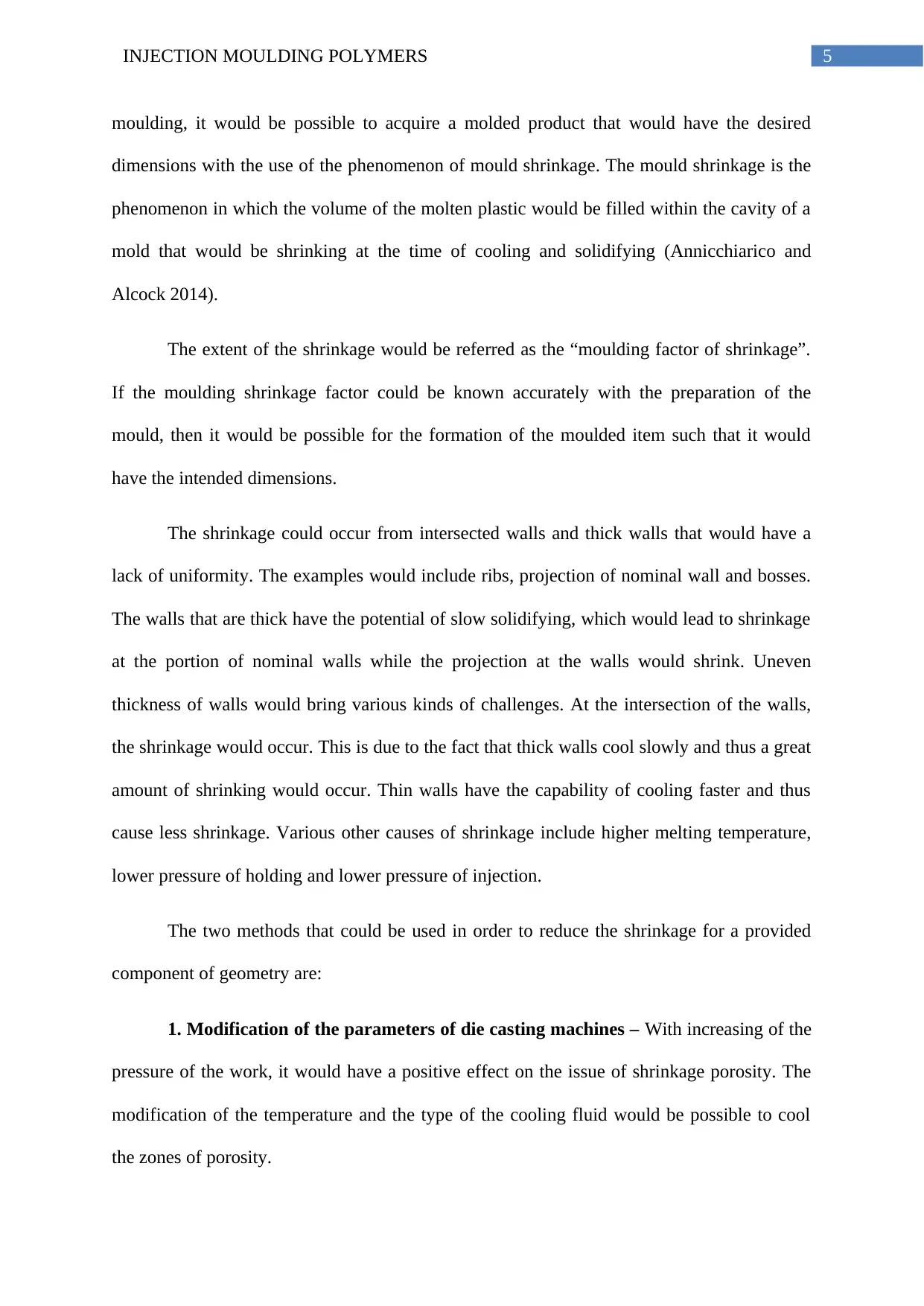
5INJECTION MOULDING POLYMERS
moulding, it would be possible to acquire a molded product that would have the desired
dimensions with the use of the phenomenon of mould shrinkage. The mould shrinkage is the
phenomenon in which the volume of the molten plastic would be filled within the cavity of a
mold that would be shrinking at the time of cooling and solidifying (Annicchiarico and
Alcock 2014).
The extent of the shrinkage would be referred as the “moulding factor of shrinkage”.
If the moulding shrinkage factor could be known accurately with the preparation of the
mould, then it would be possible for the formation of the moulded item such that it would
have the intended dimensions.
The shrinkage could occur from intersected walls and thick walls that would have a
lack of uniformity. The examples would include ribs, projection of nominal wall and bosses.
The walls that are thick have the potential of slow solidifying, which would lead to shrinkage
at the portion of nominal walls while the projection at the walls would shrink. Uneven
thickness of walls would bring various kinds of challenges. At the intersection of the walls,
the shrinkage would occur. This is due to the fact that thick walls cool slowly and thus a great
amount of shrinking would occur. Thin walls have the capability of cooling faster and thus
cause less shrinkage. Various other causes of shrinkage include higher melting temperature,
lower pressure of holding and lower pressure of injection.
The two methods that could be used in order to reduce the shrinkage for a provided
component of geometry are:
1. Modification of the parameters of die casting machines – With increasing of the
pressure of the work, it would have a positive effect on the issue of shrinkage porosity. The
modification of the temperature and the type of the cooling fluid would be possible to cool
the zones of porosity.
moulding, it would be possible to acquire a molded product that would have the desired
dimensions with the use of the phenomenon of mould shrinkage. The mould shrinkage is the
phenomenon in which the volume of the molten plastic would be filled within the cavity of a
mold that would be shrinking at the time of cooling and solidifying (Annicchiarico and
Alcock 2014).
The extent of the shrinkage would be referred as the “moulding factor of shrinkage”.
If the moulding shrinkage factor could be known accurately with the preparation of the
mould, then it would be possible for the formation of the moulded item such that it would
have the intended dimensions.
The shrinkage could occur from intersected walls and thick walls that would have a
lack of uniformity. The examples would include ribs, projection of nominal wall and bosses.
The walls that are thick have the potential of slow solidifying, which would lead to shrinkage
at the portion of nominal walls while the projection at the walls would shrink. Uneven
thickness of walls would bring various kinds of challenges. At the intersection of the walls,
the shrinkage would occur. This is due to the fact that thick walls cool slowly and thus a great
amount of shrinking would occur. Thin walls have the capability of cooling faster and thus
cause less shrinkage. Various other causes of shrinkage include higher melting temperature,
lower pressure of holding and lower pressure of injection.
The two methods that could be used in order to reduce the shrinkage for a provided
component of geometry are:
1. Modification of the parameters of die casting machines – With increasing of the
pressure of the work, it would have a positive effect on the issue of shrinkage porosity. The
modification of the temperature and the type of the cooling fluid would be possible to cool
the zones of porosity.
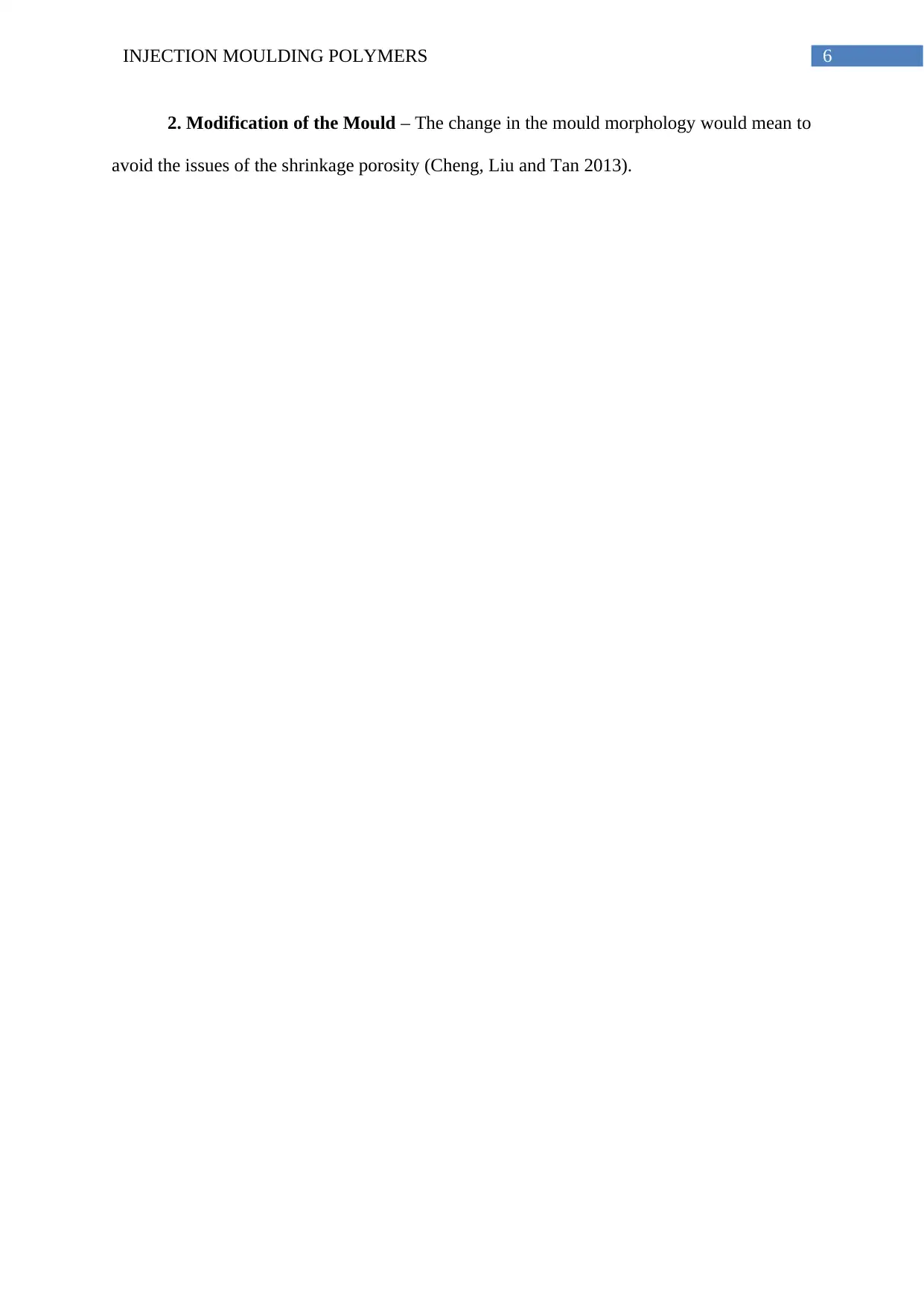
6INJECTION MOULDING POLYMERS
2. Modification of the Mould – The change in the mould morphology would mean to
avoid the issues of the shrinkage porosity (Cheng, Liu and Tan 2013).
2. Modification of the Mould – The change in the mould morphology would mean to
avoid the issues of the shrinkage porosity (Cheng, Liu and Tan 2013).
Paraphrase This Document
Need a fresh take? Get an instant paraphrase of this document with our AI Paraphraser
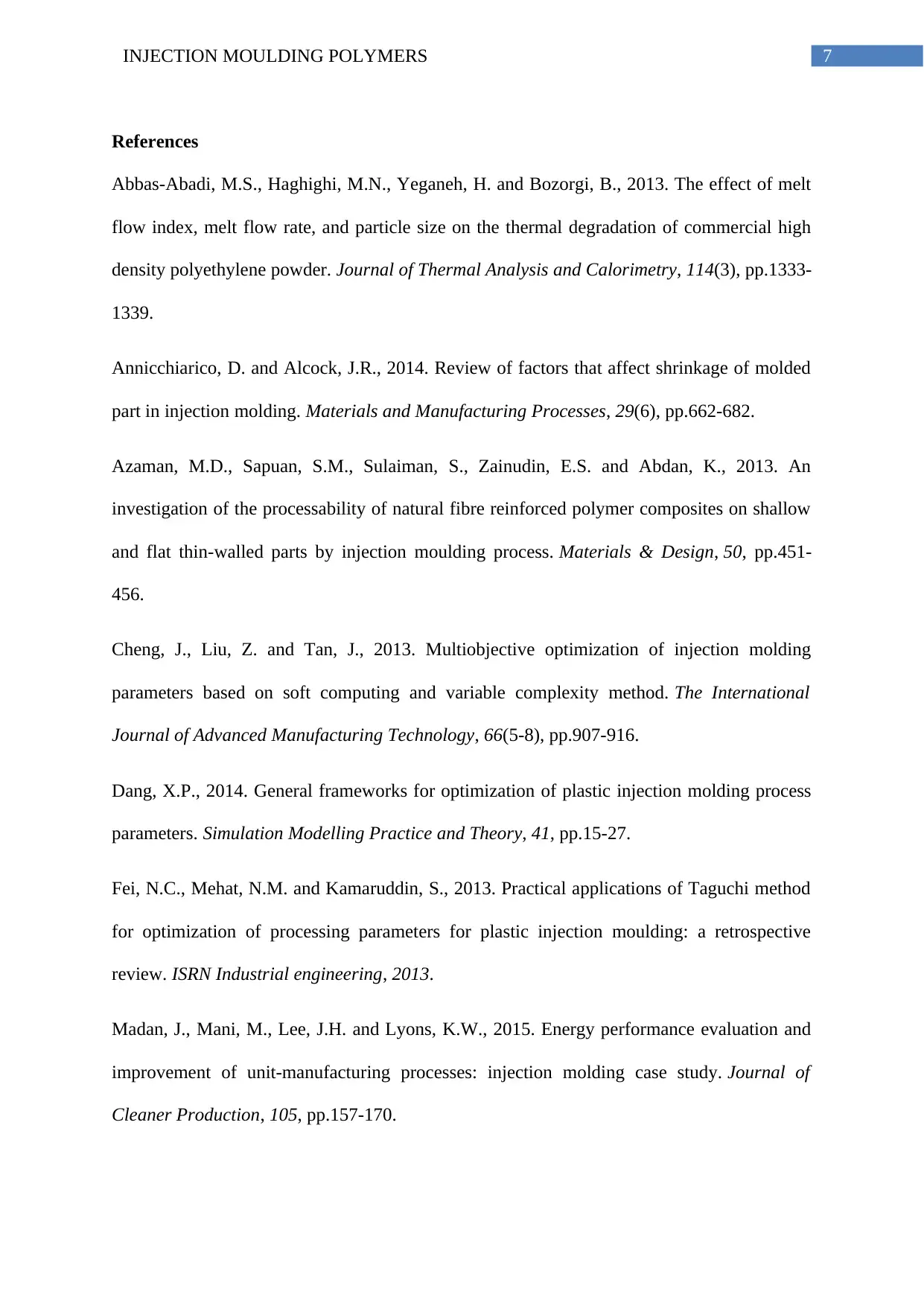
7INJECTION MOULDING POLYMERS
References
Abbas-Abadi, M.S., Haghighi, M.N., Yeganeh, H. and Bozorgi, B., 2013. The effect of melt
flow index, melt flow rate, and particle size on the thermal degradation of commercial high
density polyethylene powder. Journal of Thermal Analysis and Calorimetry, 114(3), pp.1333-
1339.
Annicchiarico, D. and Alcock, J.R., 2014. Review of factors that affect shrinkage of molded
part in injection molding. Materials and Manufacturing Processes, 29(6), pp.662-682.
Azaman, M.D., Sapuan, S.M., Sulaiman, S., Zainudin, E.S. and Abdan, K., 2013. An
investigation of the processability of natural fibre reinforced polymer composites on shallow
and flat thin-walled parts by injection moulding process. Materials & Design, 50, pp.451-
456.
Cheng, J., Liu, Z. and Tan, J., 2013. Multiobjective optimization of injection molding
parameters based on soft computing and variable complexity method. The International
Journal of Advanced Manufacturing Technology, 66(5-8), pp.907-916.
Dang, X.P., 2014. General frameworks for optimization of plastic injection molding process
parameters. Simulation Modelling Practice and Theory, 41, pp.15-27.
Fei, N.C., Mehat, N.M. and Kamaruddin, S., 2013. Practical applications of Taguchi method
for optimization of processing parameters for plastic injection moulding: a retrospective
review. ISRN Industrial engineering, 2013.
Madan, J., Mani, M., Lee, J.H. and Lyons, K.W., 2015. Energy performance evaluation and
improvement of unit-manufacturing processes: injection molding case study. Journal of
Cleaner Production, 105, pp.157-170.
References
Abbas-Abadi, M.S., Haghighi, M.N., Yeganeh, H. and Bozorgi, B., 2013. The effect of melt
flow index, melt flow rate, and particle size on the thermal degradation of commercial high
density polyethylene powder. Journal of Thermal Analysis and Calorimetry, 114(3), pp.1333-
1339.
Annicchiarico, D. and Alcock, J.R., 2014. Review of factors that affect shrinkage of molded
part in injection molding. Materials and Manufacturing Processes, 29(6), pp.662-682.
Azaman, M.D., Sapuan, S.M., Sulaiman, S., Zainudin, E.S. and Abdan, K., 2013. An
investigation of the processability of natural fibre reinforced polymer composites on shallow
and flat thin-walled parts by injection moulding process. Materials & Design, 50, pp.451-
456.
Cheng, J., Liu, Z. and Tan, J., 2013. Multiobjective optimization of injection molding
parameters based on soft computing and variable complexity method. The International
Journal of Advanced Manufacturing Technology, 66(5-8), pp.907-916.
Dang, X.P., 2014. General frameworks for optimization of plastic injection molding process
parameters. Simulation Modelling Practice and Theory, 41, pp.15-27.
Fei, N.C., Mehat, N.M. and Kamaruddin, S., 2013. Practical applications of Taguchi method
for optimization of processing parameters for plastic injection moulding: a retrospective
review. ISRN Industrial engineering, 2013.
Madan, J., Mani, M., Lee, J.H. and Lyons, K.W., 2015. Energy performance evaluation and
improvement of unit-manufacturing processes: injection molding case study. Journal of
Cleaner Production, 105, pp.157-170.
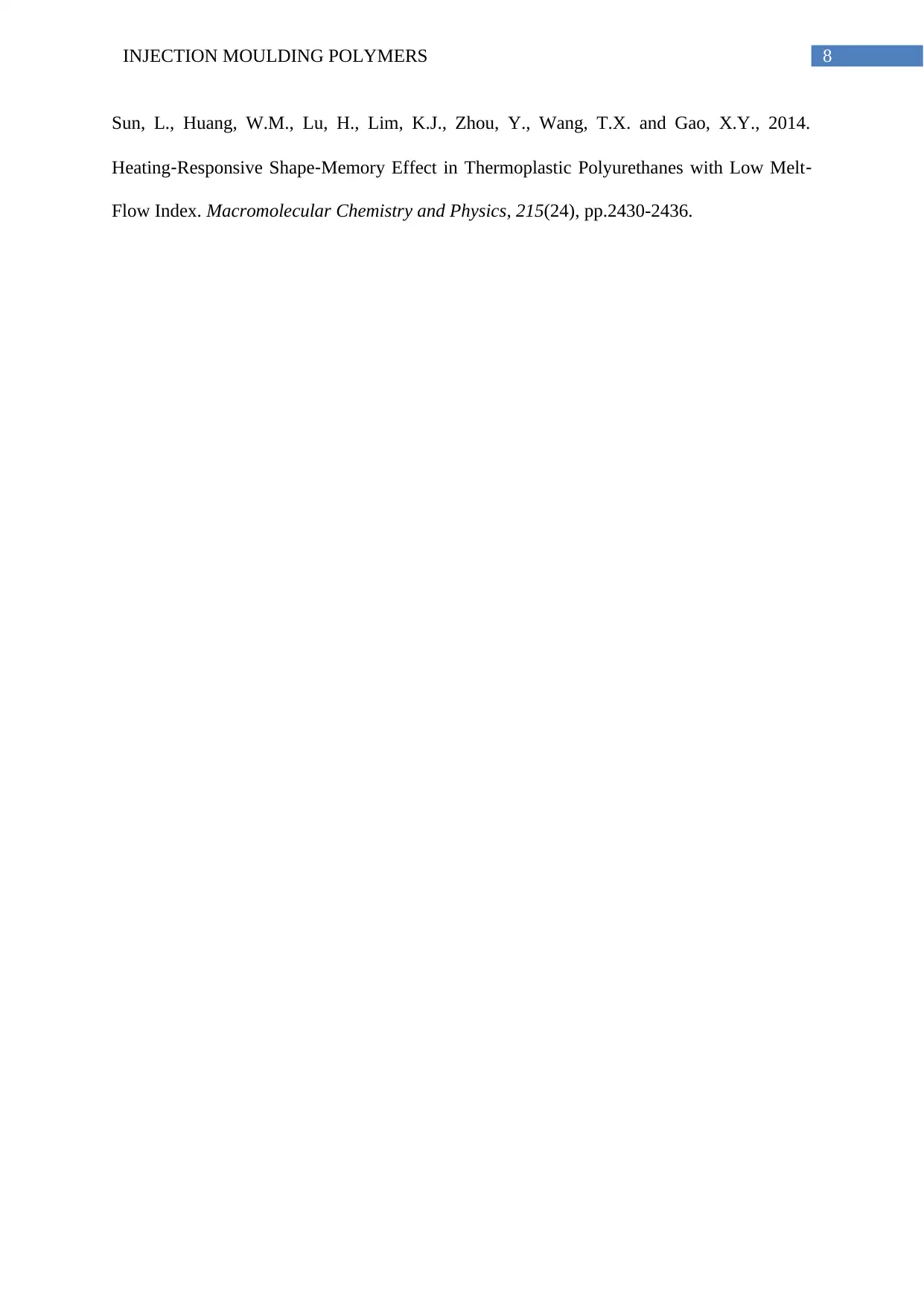
8INJECTION MOULDING POLYMERS
Sun, L., Huang, W.M., Lu, H., Lim, K.J., Zhou, Y., Wang, T.X. and Gao, X.Y., 2014.
Heating‐Responsive Shape‐Memory Effect in Thermoplastic Polyurethanes with Low Melt‐
Flow Index. Macromolecular Chemistry and Physics, 215(24), pp.2430-2436.
Sun, L., Huang, W.M., Lu, H., Lim, K.J., Zhou, Y., Wang, T.X. and Gao, X.Y., 2014.
Heating‐Responsive Shape‐Memory Effect in Thermoplastic Polyurethanes with Low Melt‐
Flow Index. Macromolecular Chemistry and Physics, 215(24), pp.2430-2436.
1 out of 9
Your All-in-One AI-Powered Toolkit for Academic Success.
+13062052269
info@desklib.com
Available 24*7 on WhatsApp / Email
![[object Object]](/_next/static/media/star-bottom.7253800d.svg)
Unlock your academic potential
© 2024 | Zucol Services PVT LTD | All rights reserved.
